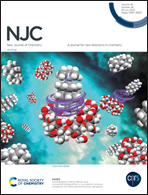Novel Fe2.55Sb2 alloy nanoparticles incorporated in N-doped carbon as a bifunctional oxygen electrocatalyst for rechargeable Zn–air batteries†
Abstract
Developing efficient earth-abundant oxygen electrocatalysts is quite significant for the commercialization of Zn–air batteries. In this study, we report novel Fe2.55Sb2 alloy nanoparticles with a mean diameter of 30–40 nm incorporated in a N-doped carbon matrix (FeSb/NC) as a bifunctional electrocatalyst for both the oxygen reduction reaction (ORR) and the oxygen evolution reaction (OER). When employed to catalyze the ORR, FeSb/NC delivers the highest onset potential of 0.91 V vs. RHE and a half-wave potential of 0.83 V vs. RHE. When used to catalyze the OER, FeSb/NC shows an overpotential of 380 mV at a current density of 10 mA cm−2. Most importantly, it could be utilized in an aqueous rechargeable Zn–air battery as the air electrode, and the battery shows a high power density of 175 mW cm−2, specific capacity of 751 mA h g−1, as well as excellent rechargeability and cycling stability (nearly 900 h at 5 mA cm−2 and over 400 h at 10 mA cm−2). These observations demonstrate that the novel FeSb/NC is an efficient oxygen electrocatalyst which is promising for use in practical energy conversion devices.



 Please wait while we load your content...
Please wait while we load your content...